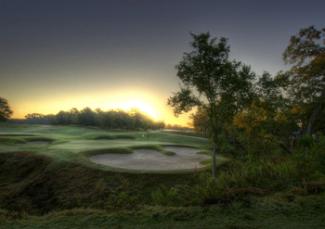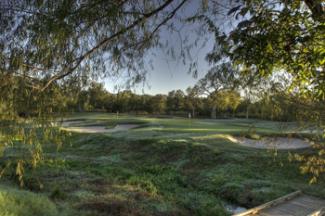Featured Golf News
Accuracy a Must at Traditions Club, Home of the Aggies
Editor's Note: This is the fourth in a series on courses of the Big 12 Conference. In previous features, Cybergolf's Steve Habel has profiled the Jimmy Austin OU Golf Club, The University of Texas Golf Club and Twin Rivers Golf Club, home of Baylor University's golf teams.

Traditions Club at Sunrise (Photo by Carlton Wade)
Welcomed with a friendly greeting of "Howdy" and a line of maroon golf carts near the bag drop, it doesn't take golfers long to know they are at the Traditions Club, home to the golf teams of Texas A&M University and host to one of this year's regionals for the 2010 NCAA Division I Men's Golf Championships.
This is the proving grounds for the Fighting Aggies' men's team, which won the 2009 NCAA Championship and has since sent a handful of players on to the professional ranks.
After playing the course while dodging a series of thunderstorms in early July and with its rough at USGA-type levels, it's easy to see how A&M was able to make the most of its opportunity in the match-play final last June. The golfer needs to be accurate to be successful at Traditions Club, and the demanding but fair layout forces you to play virtually every shot in your repertoire.
"The course is tough if you get out of the short grass, but the fairways are generous in a way not to take the driver out of your hand," said John Saffle, Traditions Club's director of golf and an Aggie golfer in the late 1980s. "We have kept the rough high to affect the shot if you are off-line, and the rains we have had this spring and summer have made the course lush and the roughs penal."
Traditions Club at Texas A&M, set on the outskirts of Bryan but near enough to see Kyle Field and the campus skyline in the breaks of the trees, opened for play in 2004.
Designed by Jack Nicklaus and his son Jack Nicklaus II, the 7,146-yard track features stately hardwoods and several natural creeks and wetlands. As Saffle noted, Traditions Club's fairways offer some relief, but the strategically placed bunkers let you know where the Nicklaus team wanted you to land your ball.
Like most other Nicklaus-designed golf courses, Traditions Club is characterized by its attention to detail and its subtle features on the tees, fairways and putting surfaces. The course plays to a rating of 74.6 and a slope of 151 from the tips.

The Green at the Third Hole (Photo by Carlton Wade)
Forced Carries & Elevated Greens Add Spice
Fourteen holes at Traditions Club sport forced carries, either over water, native areas off the tee, or on the final approach. Nine holes make you carry the ball over trouble on both shots, and on three of the four par-3s you will need to hit you ball all the way in the air to avoid hazards.
"The course is demanding because it makes you execute your shots," Saffle said. "Today's game is played in the air - especially at the college level - and the design here is reflective of the notion that a drive in the fairway can lead to a high shot over trouble to greens that are receptive but challenging."
Traditions Club's opener - a 429-yard par-4 - allows the golfer to ease into a round, and success can continue at the second, a 387-yard par-4 that moves right to left over wetlands and across a creek at the putting surface.
The 539-yard par-5 third sweeps left to right and downhill off the tee, then back up hill and over a creek and a large bunker front-left of the elevated green. It would be easy to see the college player or low handicapper go for home in two here.

The Dual Green at Tradition Club's 6th & 17th
Holes (Photo by Carlton Wade)
At 584 yards, the par-5 sixth is the longest hole at Traditions Club and its raised green, played over the creek and sandwiched between two fronting bunkers and a water-filled waste area rear, offers one of the course's most unique putting surfaces; the dual green shares a rolling expanse with the 17th.
No. 9 is - by handicap - the hardest of the one-shotters at Traditions Club, playing at 216 yards over both a native area and a deep bunker front-right and making a back-right pin placement lethal.
With water along the right for its entire length and trees and bunkers lurking left, the 559-yard par-5 10th is a handful to attack in any scenario. The elevated green moves toward the water on the right.
The final four holes at Traditions show the Nicklaus team's expertise at finding great holes on a good piece of land and should be considered the highlight of a round in Aggieland.
The 576-yard par-5 15th may be the most interesting hole on the course, turning left off the tee, then rolling downhill toward a mild slope and a target bunker set about 50 yards from the green. Again, the putting surface is elevated and guarded by a huge bunker front-left and three more right. The 27-yard deep green is slightly mounded and its back-left shelf makes for a tough target.
No. 16 is a 190-yard par-3 played over a pond and wetlands to a well-protected green. Then the round ends with two memorable par-4s. At the 427-yard 17th the drive is across a creek and into a fairway pinched at the landing area by a stand of trees. The approach is played over another creek, twice, then to the pitched green shared with the sixth hole.
The closer is the longest par-4 at Traditions Club, but the 444 yards are not the only things to consider. Two large bunkers in the landing area gobble up drives, and your move to the green is across water and to a green ringed on three sides by sand and collection areas. The hole is a fitting ultimate challenge to a testing round.
Nicklaus and son had a lot to work with on the site that became Traditions Club. Many of its rolling features were already in place thanks to the venue's proximity to so many Brazos River valley creeks and ponds, and good soil was plentiful and used well.
Traditions Club provides golfers with a true championship golf experience. Those in positions of power in the NCAA know when they see a good thing as the 2011 NCAA Division I Women's Golf Championship will be held May 17-20 at the Traditions Club, with Texas A&M University the host.
Traditions Shines off the Course
The course also offers one of the finest practice facilities in the region, with eight target greens, a 349-yard-deep Bermuda range, a 6,500-square-foot Tif-Dwarf practice green, and a 4,000-square-foot chipping area with a greenside bunker.
The facility also boasts a lifestyle facility, a swim and tennis center, and the Aggie Golf Learning Center, home of the Texas A&M golf teams. Construction of the course's much-delayed 25,000-square-foot clubhouse was finally begun last fall, and could be finished by the end of 2010.
Stay-and-play options for Traditions Club include cottages and casitas and offer overnight and extended-stay accommodations. Architecturally inspired by the 2006 Southern Living Idea House, the club's two-bedroom casitas overlook the course and are minutes from Texas A&M's campus and within walking distance of the club's amenities.
For additional information or a tee time, visit www.traditionsclub.com.
Steve Habel is one of Cybergolf's national correspondents, contributing news stories, features, equipment and book reviews and personality profiles from his base in Central Texas. He is also the managing editor for Texas CEO Magazine and works as a contributing editor for Horns Illustrated magazine, a publication focusing on University of Texas sports. He also writes a blog (www.shotoverthegreen.blogspot.com), which features news on golf and the Longhorns, and another (www.checkinginandplayingthrough.blogspot.com) on his many travels, which took him across the nation and to 105 different golf course in 2009. Habel is a member of the Golf Writers Association of America and the Texas Golf Writers Association.
Story Options
 |
Print this Story |
